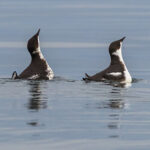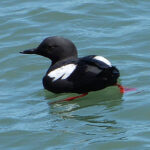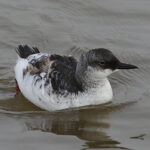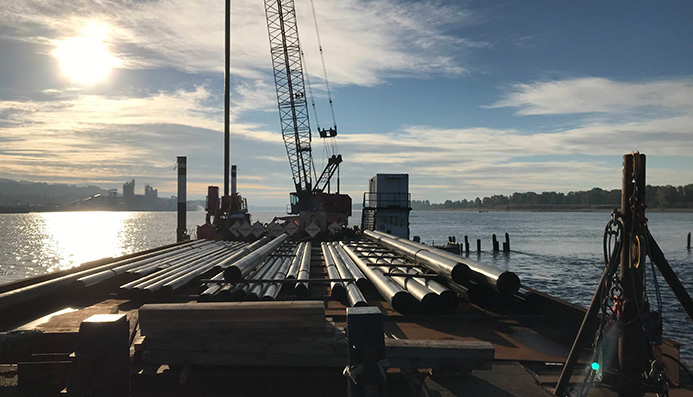
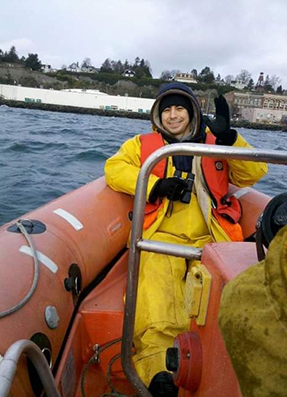
Marbled Murrelets and Marine Projects
Marbled murrelets are opportunistic diving seabirds that feed primarily on small schooling fish. They spend most of their time on the ocean resting and feeding in near-shore marine waters. As a result of nesting habitat loss and disturbances in their marine environment, marbled murrelets are federally listed as threatened under the Endangered Species Act (ESA) and are listed as an endangered species in Washington state.
Research in recent years has revealed that some project activities that cause loud noises, such as pile driving, can have negative impacts on marbled murrelets in several ways. These negative impacts can reduce the success of marbled murrelets and are all described under the term “take”. The term Take includes “to harass, harm, pursue, hunt, shoot, wound, kill, trap, capture, or collect or to attempt to engage in any such conduct”. Physical harm can potentially occur to murrelets as a result of pile driving sounds, and high underwater sound pressure can potentially cause internal hemorrhaging, physiological and neurological effects, and even mortality to diving murrelets. Additionally, behavioral effects may result from in-air sounds caused by pile driving. These in-air sounds can create a masking effect, which can make it harder for murrelets to communicate and can also cause them to become disoriented while foraging.
To help avoid and minimize potential take, the U.S. Fish and Wildlife Service (USFWS) has developed a protocol to monitor for marbled murrelets during pile driving projects. This protocol involves trained biologists observing project activities from boats, stationary platforms, and shorelines to ensure murrelets are not present within impact areas where take could occur. An important aspect of this monitoring approach is ensuring the proper identification of marbled murrelets apart from other common seabirds of the region. Below are some examples of murrelet look-alikes that marine surveyors need to distinguish.
While an adult pigeon guillemot in breeding plumage may be easier to identify from a marbled murrelet, an immature or nonbreeding pigeon guillemot can be more difficult to distinguish. Seen above: a pair of marbled murrelets in winter plumage (Left), an adult pigeon guillemot in breeding plumage (Center), and a nonbreeding pigeon guillemot (Right). Note how the marbled murrelets are dark brownish gray with a triangular white patch along their neck with a short upturned bill. The adult pigeon guillemot with breeding plumage has a solid dark head and bright red feet, with white patches on its wings. The nonbreeding pigeon guillemot has a more mottled pattern with much more white underneath, and a variable amount of black and white on the top of its head. In contrast, nonbreeding marbled murrelets have a solid black cap.
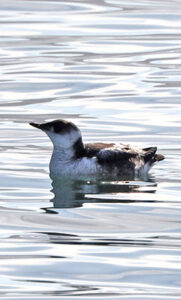
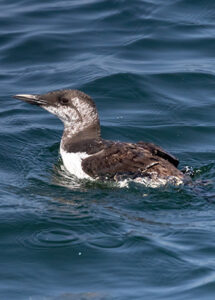
Common murres are another look-alike species to marbled murrelets. Seen above: A marbled murrelet in winter plumage (Left) and a common murre in winter plumage (right). Note the murrelet is smaller and more compact than the murre, with a distinct white collar. In contrast, the common murre has a white patch that extends up its face to behind its eye, with a distinct, curved, dark line below the eye.
It is important for clients and contractors working on piling projects to be aware of how to follow the federal and state regulations for marbled murrelets. Raedeke Associates, Inc. murrelet surveyors are certified by the USFWS to identify the subtle differences between murrelets and other similar species. Surveyors are also trained to properly understand and implement current monitoring protocols. We conduct at-sea murrelet surveys for various marine projects to comply with the requirements of the ESA and the USFWS marine monitoring protocol. These efforts help ensure that projects avoid and minimize, to the extent possible, potential take to marbled murrelets.

